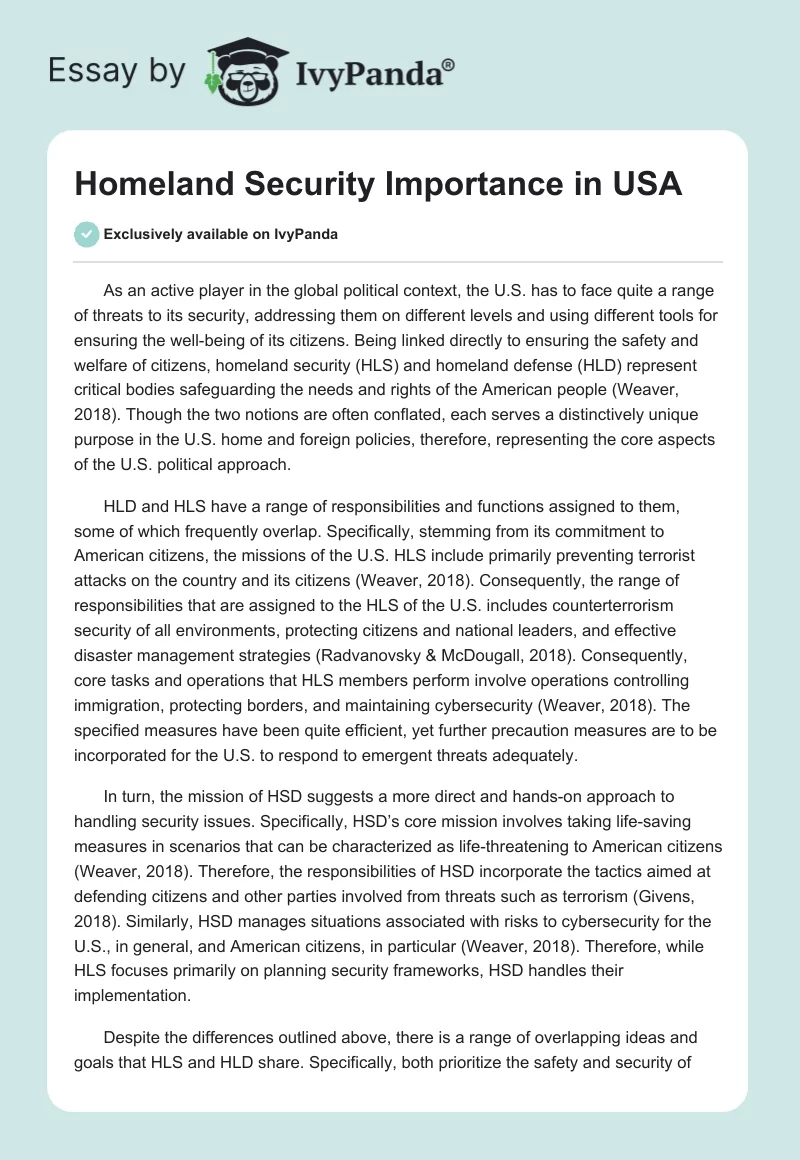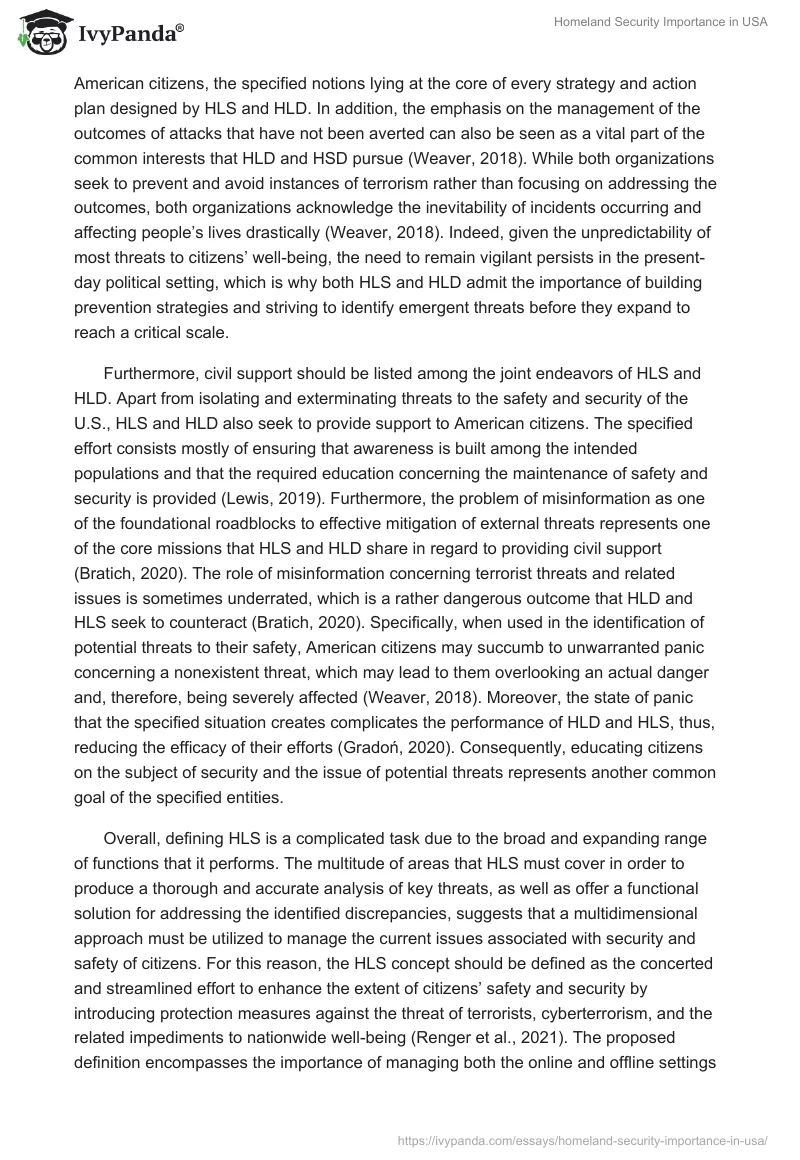As an active player in the global political context, the U.S. has to face quite a range of threats to its security, addressing them on different levels and using different tools for ensuring the well-being of its citizens. Being linked directly to ensuring the safety and welfare of citizens, homeland security (HLS) and homeland defense (HLD) represent critical bodies safeguarding the needs and rights of the American people (Weaver, 2018). Though the two notions are often conflated, each serves a distinctively unique purpose in the U.S. home and foreign policies, therefore, representing the core aspects of the U.S. political approach.
HLD and HLS have a range of responsibilities and functions assigned to them, some of which frequently overlap. Specifically, stemming from its commitment to American citizens, the missions of the U.S. HLS include primarily preventing terrorist attacks on the country and its citizens (Weaver, 2018). Consequently, the range of responsibilities that are assigned to the HLS of the U.S. includes counterterrorism security of all environments, protecting citizens and national leaders, and effective disaster management strategies (Radvanovsky & McDougall, 2018). Consequently, core tasks and operations that HLS members perform involve operations controlling immigration, protecting borders, and maintaining cybersecurity (Weaver, 2018). The specified measures have been quite efficient, yet further precaution measures are to be incorporated for the U.S. to respond to emergent threats adequately.
In turn, the mission of HSD suggests a more direct and hands-on approach to handling security issues. Specifically, HSD’s core mission involves taking life-saving measures in scenarios that can be characterized as life-threatening to American citizens (Weaver, 2018). Therefore, the responsibilities of HSD incorporate the tactics aimed at defending citizens and other parties involved from threats such as terrorism (Givens, 2018). Similarly, HSD manages situations associated with risks to cybersecurity for the U.S., in general, and American citizens, in particular (Weaver, 2018). Therefore, while HLS focuses primarily on planning security frameworks, HSD handles their implementation.
Despite the differences outlined above, there is a range of overlapping ideas and goals that HLS and HLD share. Specifically, both prioritize the safety and security of American citizens, the specified notions lying at the core of every strategy and action plan designed by HLS and HLD. In addition, the emphasis on the management of the outcomes of attacks that have not been averted can also be seen as a vital part of the common interests that HLD and HSD pursue (Weaver, 2018). While both organizations seek to prevent and avoid instances of terrorism rather than focusing on addressing the outcomes, both organizations acknowledge the inevitability of incidents occurring and affecting people’s lives drastically (Weaver, 2018). Indeed, given the unpredictability of most threats to citizens’ well-being, the need to remain vigilant persists in the present-day political setting, which is why both HLS and HLD admit the importance of building prevention strategies and striving to identify emergent threats before they expand to reach a critical scale.
Furthermore, civil support should be listed among the joint endeavors of HLS and HLD. Apart from isolating and exterminating threats to the safety and security of the U.S., HLS and HLD also seek to provide support to American citizens. The specified effort consists mostly of ensuring that awareness is built among the intended populations and that the required education concerning the maintenance of safety and security is provided (Lewis, 2019). Furthermore, the problem of misinformation as one of the foundational roadblocks to effective mitigation of external threats represents one of the core missions that HLS and HLD share in regard to providing civil support (Bratich, 2020).
The role of misinformation concerning terrorist threats and related issues is sometimes underrated, which is a rather dangerous outcome that HLD and HLS seek to counteract (Bratich, 2020). Specifically, when used in the identification of potential threats to their safety, American citizens may succumb to unwarranted panic concerning a nonexistent threat, which may lead to them overlooking an actual danger and, therefore, being severely affected (Weaver, 2018). Moreover, the state of panic that the specified situation creates complicates the performance of HLD and HLS, thus, reducing the efficacy of their efforts (Gradoń, 2020). Consequently, educating citizens on the subject of security and the issue of potential threats represents another common goal of the specified entities.
Overall, defining HLS is a complicated task due to the broad and expanding range of functions that it performs. The multitude of areas that HLS must cover in order to produce a thorough and accurate analysis of key threats, as well as offer a functional solution for addressing the identified discrepancies, suggests that a multidimensional approach must be utilized to manage the current issues associated with security and safety of citizens. For this reason, the HLS concept should be defined as the concerted and streamlined effort to enhance the extent of citizens’ safety and security by introducing protection measures against the threat of terrorists, cyberterrorism, and the related impediments to nationwide well-being (Renger et al., 2021). The proposed definition encompasses the importance of managing both the online and offline settings to keep the extent of citizens’ safety and isolate instances of suspicious activity that may involve plotting a breach of national security.
Furthermore, the proposed definition contributes to the identification of the further directions in which HLS and HLD must evolve. Specifically, the importance of recognizing cyberthreats as a legitimate danger to the well-being of the American population is outlined in the specified definition. Given the increase in the drop of control over online communication, the probability of digital tools being used as the means of plotting an act of terror against U.S. citizens or utilizing g it in any other way that undermines the state security becomes highly probable (Smith, 2018). In turn, the proposed definition indicates the areas that must be explored to address the described gap, thus, minimizing the emerging threat.
Since the rise in the probability of digital communication tools being misused to undermine the safety of American citizens by terrorists, it is strongly recommended to pay additional attention to the introduction of digital tools and strategies for managing state security and supervising the target political setting. Thus, emergent threats to the population’s security and safety will be identified more easily, thus, making it possible to prevent a breach of security rather than mitigate its unfortunate effects (Weaver, 2018). Specifically, additional digital protections must be incorporated into the network for safeguarding national infrastructure, crucial information, and relevant data (Weaver, 2018). Namely, contingency plans and focus on building awareness must represent the core focus of the HLS approach to the subject matter.
Additionally, the issue of uncertainty, particularly, in relation to risks that the U.S. is facing, needs to be addressed in a more productive manner. Specifically, while the existing approach to data management allows making quite reliable general forecasts, the issue of preventing acts of terror remains a major problem due to the random nature thereof and the associated complications (Eller & Wandt, 2020). For this reason, the focus on improved surveillance and better data management must be placed immediately to create the platform for enhanced supervision of the target setting (Eller & Wandt, 2020). Thus, instances that may pose a major threat to the safety and security of American citizens can be averted successfully.
Applying the Ends, Ways, and Means framework to the problem outlined above, one will have to admit that the issue at hand will require a complex solution. Specifically, the ends to be achieved can be defined as an increased level of security for U.S. citizens. In turn, the means that will help attain the outlined goal include the enhancement of digital surveillance and control development (Alasgarli, 2019). Finally, the means to achieve the specified outcome include providing better digital education both for members of HLS and American citizens, in general. Thus, major threats will be recognized and avoided or prevented from happening in the first place.
Despite being often seen as interchangeable notions, HLD and HLS are, in fact, entirely different concepts, each playing a unique role in the management of core political goals of the U.S., namely, ensuring the safety of American citizens. Shielding the U.S. population and the country, in general, from external aggression, HLS and HLD forces serve to maintain the political, economic, and sociocultural development of the United States and its citizens. Furthermore, to enhance the performance of the American HLS and HLD bodies, the U. S. government will have to focus on building and improving the digital strategy for detecting, addressing, and preventing instances of a security breach, primarily, terrorism. The proposed course of action will help improve the current situation substantially.
Reference
Alasgarli, E. (2019). How much successful the traditional strategy-making models in the contemporary strategic environment? The analysis of the ends, ways and means formula. Journal of Defense Resources Management (JoDRM), 10(2), 30-39. Web.
Bratich, J. (2020). Civil society must be defended: Misinformation, moral panics, and wars of restoration. Communication, Culture, and Critique, 13(3), 311-332. Web.
Eller, W. S., & Wandt, A. S. (2020). Contemporary policy challenges in protecting the homeland. Policy studies journal, 48, S33-S46. Web.
Givens, A. D., Busch, N. E., & Bersin, A. D. (2018). Going global: The international dimensions of US homeland security policy. Journal of Strategic Security, 11(3), 1-34. Web.
Gradoń, K. (2020). Crime in the time of the plague: Fake news pandemic and the challenges to law-enforcement and intelligence community.Society Register, 4(2), 133-148. Web.
Lewis, T. G. (2019). Critical infrastructure protection in homeland security: defending a networked nation. John Wiley & Sons.
Radvanovsky, R., & McDougall, A. (2018). Critical infrastructure: homeland security and emergency preparedness. CRC Press.
Renger, R., Renger, J., Basson, M. D., Van Eck, R. N., Renger, J., Souvannasacd, E., & Hart, G. (2021). Using the Homeland Security Exercise and Evaluation Program (HSEEP) building block approach to implement System Evaluation Theory (SET). American Journal of Evaluation, 42(4), 586-601. Web.
Smith, D. C. (2018). Enhancing cybersecurity in the energy sector: a critical priority. Journal of Energy & Natural Resources Law, 36(4), 373-380. Web.
Weaver, J. M. (2018). The 2017 National Security Strategy of the United States. Journal of Strategic Security, 11(1), 62-71. Web.


